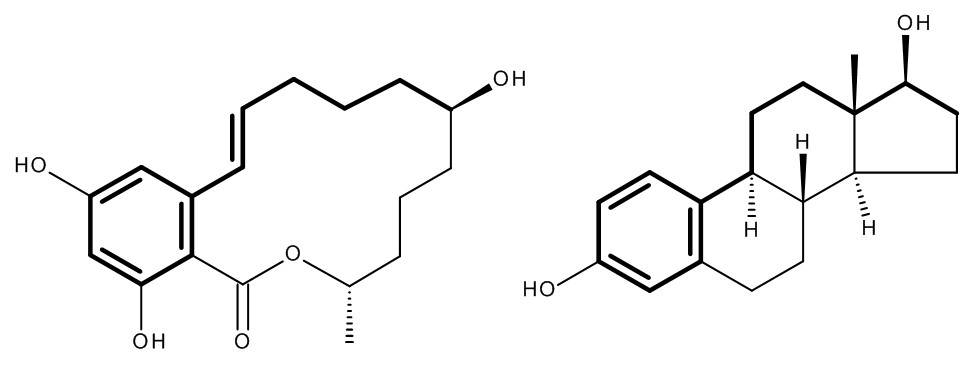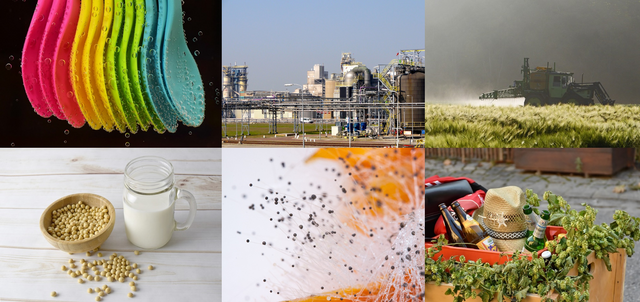Xenoestrogens #2: Why are some compounds acting as endocrine disruptors, and where do they occur?
This is the English adaption of my recent german post. Sorry for the delay, RL is stressy too.^^
In the first part of this article series, we learned how estrogenicity is mediated through estrogen receptors and how important a error-free functionality of the endocrine system is.
So now we are able to adress the actual topic: Xenoestrogens, i.e. compounds that are not produced by ourselves (xeno=alien, foreign) but also show estrogen-like hormonal effects and thus - in the worst case - are able to disturb our natural hormone balance (the so-called "endocrine disruption").
Estrogens, everywhere estrogens. Pictures from pixabay(CC0)
This post aims at clarifying what chemical properties determine an endocrine disruptor, and then will give you a short overview of the most important known xenoestrogens and where they are found.
From estrogenic effects to the endocrine disruption
Key and lock
As we already learned last week, a compound has to be able to bind to a certain region of the estrogen receptor (ER) protein to act estrogenic. Even more plastically spoken: It has to be "a fitting key to the ER lock".
Thus, our xenoestrogen molecule should be similar in size, charge distribution and assembly of so-called "funcional groups" as natural estrogens. We usually draw chemicals in 2D, while in reality they are 3-dimensional and thus look very different, so this "structural analogy" is often not visible at a first glance. But sometimes it is, e.g. here:

The structural similarity of α-zearalenol (left) with the natural estrogen E2 (right).
Unluckily, the ER "lock" is quite unspecific, so there are lots of compounds that are partially fitting "keys". But happily, not all of those xenoestrogens are endocrine disruptive.
uptake & metabolism
To be able to influence our endocrine system, a comound has to be able to reach our organs - and thus the bloodstream - first. And this ain't easy.
There are three main ways for unwanted chemicals to enter our body: The air we breath, diffusion through the skin or oral uptake. Most xenoestrogens we are exposed to are only going the third way: they have to be part of our food or drink. But to take the way from our mouth to our blood, a chemical has to be:
- chemically stable enough to survive the extreme conditions of our gastrointestinal system (e.g. stomach acids or the enzymatic activity of our gut bacteria)
- soluble enough in fat to pass the gastrointestinal membrane
- resistant enough against our intrinsic metabolic system* to survive the liver
And many xenoestrogens aren't. For example anthocyanins, the blue/reddish colors of many berries, act estrogenic in high concentrations, we can measure this in cultured cells. But if you eat them, they won't effect you at all, because they will never be found in sufficient concentrations in your blood to act estrogenic there.(Source)
But still, Xenoestrogens that are able to reach our blood and thus exert unwanted endocrine effects do exist.
*see The xenobiotic metabolism, one of my older posts from the time when I was still qualified to receive @curie upvotes...
Classifying xenoestrogens
We can roughly divide xenoestrogens by means of their origin. Very often, people distinguish synthetic from naturally occurring comounds.
The former are artificially created chemicals that can get into contact with humans or nature and possess estrogenic properties just by (bad) luck.
The latter are produced by plants ("phytoestrogens") or mold fungi ("mycoestrogens"). Here, the endocrine activity might not be an accident. Nature isn't so much an idyllic utopia, but a eternal fight between different life forms on ever scarce resources. That's why Darwin called its history - evolution - survival of the fittest.
Estrogens are used by all vertebrates and some insects for sexual reproduction, and thus compounds that impair this ability have been established as biochemical weapons against enemies. From the perspective of a plant, an animal or insect that wants to eat its fruits or flowers is the enemy that has to be combated with poisons and hormone mimicking chemicals (i.e. natural pesticides).
Let's keep this classification by means of origin for now, but please note that the origin of a xenoestrogen does state nothing about it's hazardeous strength. Natural poisons can be as unpleasent as artificial ones.
So where do we find endocrine disruptors now? For humans, the following xenoestrogens are of the greatest relevance:
pesticides, amongst others:
- DDT, a chemical widely used as insectizide until the 1970ies. Was then banned in most industrial nations after it caused severe reproductive errors in animals (e.g. extremly thin egg shells in birds).
- Atrazine, a herbicide that was banned by the EU in 2006, but is still used in the US. It's endocrine activity has been proven, but there's still a lot of bickering over the risks for consumers in the US. Shoud TTIP revive from the dead, we Europeans will inherit this problem again, too.
- Endosulfan, another herbicide
industrial chemicals
Those are usually of very low risk to the average human being, as it's not so easy to get exposed to them. But they are - of course - relevant as environmental pollutants. If they are disposed in waters, this can have terrible consequences for water animals, as those literally have to live in the chemicals and thus comparably small concentrations of xenoestrogens can completely mess up their reproductive capabilities. Examples for such industrial xenoestrogens are:
- Dioxines
- PPBs, which are today hardly found outside of sythesis labs. Historically, they have been widely used as coolants (e.g. in refrigerators) until the late 1970ies.
plastics
Now here's the hot topic. Everyone has heard about hormones in plastics. Yes, in some (but not all!) kinds of plastics, xenoestrogens can be found. Of special relevance are:
- the infamous bisphenol A (BPA), which is used to produce polycarbonate and epoxy resin (e.g. inner coating of cans). In 2009, the EU spectacularily banned BPA from being used in infant bottles (but if I'm not mistaken it's still legal in the US). In 2015, the EFSA (the "European FDA") lowered the legal boundary values again, and at the moment they completely re-evaluate the compound, a process that is widely expected to lead to even harsher regulations (which I personally think is absolutly justified).
- Phtalates, which are widely used as plasticizers in different plastics, particularly PVC
Phytoestrogens
Lots of plants produce estrogens, but for human health, plant-derived xenoestrogens are mostly relevant if those plants are part of our diet. Of course it's interesting to know (and used in herbal medicine) that they can be found in red clover (there's even a related "red clover disease" in sheep), but normal people won't have clover for supper very often...
For us, the most important phytoestrogens are:
- isoflavones, which can be found in soy beans soy products
- iso-xanthohumol und 8-prenylnaringenin (8-PN), which occur in hops and thus also in beer. Nooooooooooooooooooooooooooooooooooooooooooooooooooooooooooooooooooooooooooooooooooooooooooooooooooooooooooooooooooooo! - Oh sorry, was that me?
By the way, 8-PN is the most potent phytoestrogen known to date. But an article on this and why beer is still ok is coming, don't panic. Breathe, Sco, breathe.
mycoestrogens
Mycoestrogens are estrogenic metabolites of molds, which are frequently found as food contaminants. The most famous compounds of that group are zearalenone (ZEN) α-zearalenol (ZEL) which are produced by Fusarium fungi who are growing on corn and other cereals. ZEN and ZEL are two of the very few mycotoxins which are regulated by law, which means there are boundary values that have to be respected by food producers if they want to sell their product.
Conclusion
As you can see, there is a great variety of xenoestrogens, and it will take us some more posts to cover the most important ones.
My English readers will have to remain patient, as the next project will be to recap my posts on soy isoflavones (click here, here, or here) for my german audience. But we'll see each other again, I promise.
Until then, please note: Just because a chemical occurred in my little (and by no means complete) list, it doesn't mean it is dangerous for you as long as you don't take up way too much on a regular base!
And most inportantly, I have to remind you to take to heart what is written on the cover of the hitchhiker's guide:
Don't panic!
additional sources:
Just like the last time I wrote much from memory, as I am working with xenoestrogens in the lab and thus know my part - at least concerning the mechanisms involved. Wo wants to cross-check my work, our to learn more details, can find all relevant information here:
Toxikologie: Eine Einführung für Chemiker, Biologen und Pharmazeuten. Book by Prof. W. Dekant
Wiki: endocrine disruptors
wiki: phytoestrogens
EFSA: Zearalenon
EFSA reevaluates BPA
Disclaimer: In my blog, I'm stating my honest opinion as a researcher, not less and not more. Sometimes I make errors. Discuss and disagree with me - if you are bringing the better arguments, I might rethink.

Sunday is usually the quietest day on Steemit, but there are plenty of good posts today.
Thanks for 8-prenylnaringenin (8-PN), I will use it as excuse
you need an excuse not to drink beer? The only acceptable reason for that is you're wine drinker.
:D
So isoflavones from soy beans can actually exert endocrine effects in human body?
yes and no. Isolated and concentrated as supplement, they can without a doubt. They eventually also have effects on infant girls, e.g. via soy-based formula - but not on boys.
However, in the quantities found in food, they will not affect an adult.
But I wrote 3 posts on them recently, it's all in there.
Thanks, I was confused because you mentioned them here together with xenoestrogens with effects on human health - but definitely they need to be concentrated to have an effect in adults.
yes, definatly. I wouldn't feed soy to a baby girl, though.
Thanks for this post
you're welcome